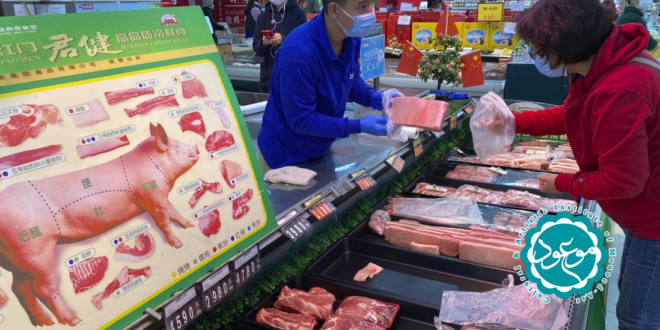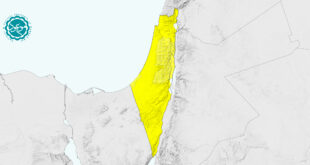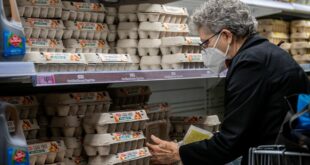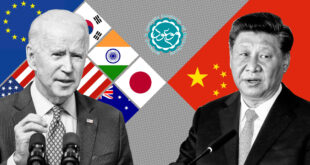According to Mouood, quoting by scmp:
China food security: why is it important and what caused November’s panic buying?
China needs to feed 1.4 billion people, but African swine fever, the coronavirus and natural disasters have recently raised questions about food security Imports play a key role in China’s food supply chain, but Beijing is also keen to boost the nation’s self-sufficiency
What caused a bout of panic buying in China in November?
It started with a notice from China’s Ministry of Commerce on November 1, 2021, telling local authorities to stabilise food supply and prices, including for vegetables, meat and cooking oil in preparation for the coming cold months.
“Families are encouraged to store a certain amount of daily necessities to meet the needs of daily life and emergencies,” the ministry said.
This sparked heated discussion online, with some users even speculating the call to stockpile food was related to the possible outbreak of war with Taiwan.
The Ministry of Commerce responded by assuring people there was no imminent threat to food supply, while the state-run Economic Daily newspaper also tried to calm online speculation by saying the intention of the notice was to make sure people were prepared for lockdowns or quarantine due to new coronavirus outbreaks.
“In the long run, it is also advocating for residents to improve their awareness of emergency management, increase the household reserve of necessary commodities to supplement the national emergency system,” it said in a piece published on its WeChat channel.
This did not stop some shoppers stocking up on cabbage, rice and flour, while the instructions also pushed up domestic edible oil futures, as well as Malaysian palm oil.
Long lines were seen at some supermarkets, but many residents said there was no need to purchase more food than normal.
Why is China’s food security important?
China needs to feed its 1.4 billion people, around one fifth of the world’s population.
The memory of China’s Great Famine that swept the country from 1958-62 is still seared into the hearts of older generations.
It was precipitated by Mao Zedong’s Great Leap Forward, a radical campaign aimed at turning China into a communist utopia through rapid industrialization and collectivization, but which instead led to the deaths of tens of millions of people.
In a turbulent post-coronavirus world, ensuring food security has become an increasingly crucial political priority for Beijing’s new development strategy, which relies more on domestic consumption to offset external uncertainties.
President Xi Jinping has said that the rice bowl of China must be firmly kept in Chinese hands, meaning the country must ensure absolute safety in the supply of grains.
What does China do to protect its food security?
China decided to establish national grain stockpiles in 1990, and has now built up a system “coordinating central state reserves and local reserves, and complementing government and corporate inventories with each other”.
The country introduced an accountability mechanism combined with detailed assessment criteria in 2015 that requires all provincial governors to take full responsibility for local food security.
In a bid to protect its limited land resources, Beijing also set a minimum national level for cultivated farmland at 120 million hectares (297 million acres).
The government has also set a target to reach 71.67 million hectares of “high-standard farmland” by 2025 and then 80 million hectares by 2030, all of which will be used for large-scale mechanical farming to increase crop yields per acre.
For the first time, policymakers also set a compulsory target for grain production in the 14th Five-Year Plan released this March.
Meanwhile, China has increased its imports of soybeans and corn to ensure self-sufficiency in staple grains, including wheat and rice.

In August 2020, Xi asked people not to waste food, which was immediately transformed into a national campaign.
Following the bout of panic-buying in China in November, Qin Yuyun, an official at the National Food and Strategic Reserves Administration, said total grain reserves were currently sufficient and stocks of wheat and rice continued to increase.
Qin said that supply in the domestic grain market was fully guaranteed, with China’s annual grain output in 2021 projected to exceed 650 billion kilograms for the seventh consecutive year.
He said China’s current grain reserves were at a historically high level, while wheat stocks were expanding and sufficient to meet demand for 18 months.
China was “basically self-sufficient in grain with the supply of staple food absolutely safe,” he said.
The country’s food supply has also been strengthened, Qin said, citing adequate stocks of rice and flour products, as well as grain and oil processing capabilities.
Does China rely on overseas imports to ensure its food security?
“Moderate imports” is a part of China’s official strategy on food security, according to a government white paper issued in October 2019.
Cheng Guoqiang, a member of the National Food Security Policy Expert Advisory Committee and a professor at Tongji University, said the country has to leverage imports to demand because of a domestic planting shortage of 90 million hectares.
At the price of being dependent on foreign soybeans, China is able to ensure enough land for self-sufficiency in production of rice and wheat, two major staple crops.
China is already the world’s largest importer of food. Since 2014, the country’s grain imports have remained above 100 million tonnes.
It imported 128.27 million tonnes of grain during the first 9 months of 2021, up 29.3 per cent from a year earlier.
China imported 3.53 million tonnes of corn in September, up 226.9 per cent from a year ago, while the purchase of foreign wheat dropped 40.4 per cent to 640,000 tonnes in September.
China, though, is still a net exporter of rice, meaning it exports more than it imports.
Does China still have a pork crisis?
Food prices fell by 5.2 per cent from a year earlier in September 2021, down from a fall of 4.1 per cent in August. This was largely due to the price of pork – a staple meat on Chinese plates – falling by 46.9 per cent compared with a year earlier in September.
China’s huge hog sector is actually struggling with excess production after millions of small, often first-time, pig farmers entered the industry to capitalize on record profits during a swine-fever related shortage.
Prices are now hovering below the cost of production, with the government urging farmers to cull their herds.
How China’s pork crisis put the squeeze on struggling family pig farms
China’s top leadership had called for an urgent recovery in the sector following a nationwide outbreak of the deadly African swine fever virus that halved the country’s 447 million-strong herd.
“Now the stock of fertile sows in the country is still 6 per cent more than the normal number, and it is not expected to return to a reasonable level until early next year. It is hoped that everyone will buy more pork and eat more pork, which can not only enrich the nutrition of ordinary people but also alleviate the operational difficulties of farmers,” Chen Guanghua, an official at the Ministry of Agriculture and Rural Affairs, said at a press conference on November 4.
Profits initially boomed in line with higher prices for pork, the country’s favourite meat, but surging output and coronavirus-linked demand interruptions have driven down prices by 70 per cent this year, causing heavy producer losses over the past three months.
More than 2 million small farmers entered the sector last year, according to official data, joining an estimated 20 million small-scale pig producers, while some 16,000 new large-scale farms also began operating.
 Mouood Mouood English Edition
Mouood Mouood English Edition




